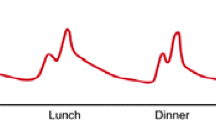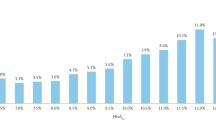Abstract
Hypoglycemia and fear of hypoglycemia limit appropriate glycemic control in many children and adolescents with type 1 diabetes. Traditional approaches to the prevention of hypoglycemia including patient education about modifiable risk factors for hypoglycemia (changes in insulin, diet, and exercise) and frequency of self glucose monitoring remain important for hypoglycemia prevention. Continuous glucose monitoring systems with or without a partial closed-loop control of insulin infusion have been very useful in the prevention of hypoglycemia. Oral carbohydrate and parenteral glucagon continue to be the mainstays of hypoglycemia treatment. In the future, we can look forward to regulatory approval of closed-loop insulin delivery and glucose monitoring systems to facilitate euglycemia, as well as glucagon administered by the intranasal route to treat hypoglycemia.
Similar content being viewed by others
References
Papers of particular interest, published recently, have been highlighted as: • Of importance •• Of major importance
Karges B, Kapellen T, Wagner VM, Steigleder-Schweiger C, Karges W, Holl RW, et al. Glycated hemoglobin A1c as a risk factor for severe hypoglycemia in pediatric type 1 diabetes. Pediat Diabetes 2015. doi:10.1111/pedi.12348
Barnard K, Thomas S, Royle P, Noyes K, Waugh N. Fear of hypoglycaemia in parents of young children with type 1 diabetes: a systematic review. BMC Pediatr. 2010;10:50.
Johnson SR, Cooper MN, Davis EA, Jones TW. Hypoglycaemia, fear of hypoglycaemia and quality of life in children with Type 1 diabetes and their parents. Diabetic Med: J Br Diabetic Assoc. 2013;30:1126–31.
Freckleton E, Sharpe L, Mullan B. The relationship between maternal fear of hypoglycaemia and adherence in children with type-1 diabetes. Int J Behav Med. 2014;21:804–10.
Arbelaez AM, Semenkovich K, Hershey T. Glycemic extremes in youth with T1DM: the structural and functional integrity of the developing brain. Pediatr Diabetes. 2013;14:541–53.
McNeilly AD, McCrimmon RJ. The Scylla and Charybdis of glucose control in childhood type 1 diabetes? Pediatr Diabetes. 2015;16:235–41.
Cameron FJ. The impact of diabetes on brain function in childhood and adolescence. Pediatr Clin N Am. 2015;62:911–27.
Gaudieri PA, Chen R, Greer TF, Holmes CS. Cognitive function in children with type 1 diabetes: a meta-analysis. Diabetes Care. 2008;31:1892–7.
Mauras N, Mazaika P, Buckingham B, Weinzimer S, White NH, Tsalikian E, et al. Longitudinal assessment of neuroanatomical and cognitive differences in young children with type 1 diabetes: association with hyperglycemia. Diabetes. 2015;64:1770–9. This paper suggests that chronic hyperglycemia is much more likely to induce neuroanatomic structural changes and congitive loss than hypoglycemia.
Marzelli MJ, Mazaika PK, Barnea-Goraly N, Hershey T, Tsalikian E, Tamborlane W, et al. Neuroanatomical correlates of dysglycemia in young children with type 1 diabetes. Diabetes. 2014;63:343–53.
Barnea-Goraly N, Raman M, Mazaika P, Marzelli M, Hershey T, Weinzimer SA, et al. Alterations in white matter structure in young children with type 1 diabetes. Diabetes Care. 2014;37:332–40.
Hershey T, Perantie DC, Wu J, Weaver PM, Black KJ, White NH. Hippocampal volumes in youth with type 1 diabetes. Diabetes. 2010;59:236–41.
Perantie DC, Wu J, Koller JM, Lim A, Warren SL, Black KJ, et al. Regional brain volume differences associated with hyperglycemia and severe hypoglycemia in youth with type 1 diabetes. Diabetes Care. 2007;30:2331–7.
Wilson DM, Calhoun PM, Maahs DM, Chase HP, Messer L, Buckingham BA, et al. Factors associated with nocturnal hypoglycemia in at-risk adolescents and young adults with type 1 diabetes. Diabetes Technol Ther. 2015;17:385–91. This paper examines the correlates of nocturnal hypoglycemia with exercise and other behaviors.
Chiang JL, Kirkman MS, Laffel LM, Peters AL. Type 1 diabetes through the life span: a position statement of the American Diabetes Association. Diabetes Care. 2014;37:2034–54.
Seaquist ER, Anderson J, Childs B, Cryer P, Dagogo-Jack S, Fish L, et al. Hypoglycemia and diabetes: a report of a workgroup of the American Diabetes Association and the Endocrine Society. J Clin Endocrinol Metab. 2013;98:1845–59. This consensus review discusses the etiology and prevention of hypoglycemia in people with diabetes across the lifespan.
McMahon SK, Ferreira LD, Ratnam N, Davey RJ, Youngs LM, Davis EA, et al. Glucose requirements to maintain euglycemia after moderate-intensity afternoon exercise in adolescents with type 1 diabetes are increased in a biphasic manner. J Clin Endocrinol Metab. 2007;92:963–8.
Tsalikian E, Mauras N, Beck RW, Tamborlane WV, Janz KF, Chase HP, et al. Impact of exercise on overnight glycemic control in children with type 1 diabetes mellitus. J Pediatr. 2005;147:528–34.
Metcalf KM, Singhvi A, Tsalikian E, Tansey MJ, Zimmerman MB, Esliger DW, et al. Effects of moderate-to-vigorous intensity physical activity on overnight and next-day hypoglycemia in active adolescents with type 1 diabetes. Diabetes Care. 2014;37:1272–8. This study confirms the effects of the timing of exercise on glycemia for a day or more.
Gomez AM, Gomez C, Aschner P, Veloza A, Munoz O, Rubio C, et al. Effects of performing morning versus afternoon exercise on glycemic control and hypoglycemia frequency in type 1 diabetes patients on sensor-augmented insulin pump therapy. J Diabetes Sci Technol. 2015;9:619–24.
Taplin CE, Cobry E, Messer L, McFann K, Chase HP, Fiallo-Scharer R. Preventing post-exercise nocturnal hypoglycemia in children with type 1 diabetes. J Pediatr. 2010;157:784–8. e1.
Tsalikian E, Kollman C, Tamborlane WB, Beck RW, Fiallo-Scharer R, Fox L, et al. Prevention of hypoglycemia during exercise in children with type 1 diabetes by suspending basal insulin. Diabetes Care. 2006;29:2200–4.
Robertson K, Riddell MC, Guinhouya BC, Adolfsson P, Hanas R, ISPAD Clinical Practice Consensus Guidelines. Exercise in children and adolescents with diabetes. Pediatr Diabetes. 2014;15 Suppl 20:203–23. This consensus guideline discusses how to prevent and treat hypoglycemia associated with exercise in children.
Kaufman FR, Devgan S. Use of uncooked cornstarch to avert nocturnal hypoglycemia in children and adolescents with type I diabetes. J Diabetes Complicat. 1996;10:84–7.
Kaufman FR, Halvorson M, Kaufman ND. Evaluation of a snack bar containing uncooked cornstarch in subjects with diabetes. Diabetes Res Clin Pract. 1997;35:27–33.
Kaufman FR, Halvorson M, Kaufman ND. A randomized, blinded trial of uncooked cornstarch to diminish nocturnal hypoglycemia at diabetes camp. Diabetes Res Clin Pract. 1995;30:205–9.
Detlofson I, Kroon M, Aman J. Oral bedtime cornstarch supplementation reduces the risk for nocturnal hypoglycaemia in young children with type 1 diabetes. Acta Paediatr. 1999;88:595–7.
Moheet A, Mangia S, Kumar A, Tesfaye N, Eberly LE, Bai Y, et al. Naltrexone for treatment of impaired awareness of hypoglycemia in type 1 diabetes: a randomized clinical trial. J Diabetes Complicat. 2015;29:1277–82.
Tamborlane WV, Beck RW, Bode BW, Buckingham B, Chase HP, Clemons R, et al. Continuous glucose monitoring and intensive treatment of type 1 diabetes. N Engl J Med. 2008;359:1464–76.
Beck RW, Hirsch IB, Laffel L, Tamborlane WV, Bode BW, Buckingham B, et al. The effect of continuous glucose monitoring in well-controlled type 1 diabetes. Diabetes Care. 2009;32:1378–83.
Bergenstal RM, Klonoff DC, Garg SK, Bode BW, Meredith M, Slover RH, et al. Threshold-based insulin-pump interruption for reduction of hypoglycemia. N Engl J Med. 2013;369:224–32.
Ly TT, Nicholas JA, Retterath A, Lim EM, Davis EA, Jones TW. Effect of sensor-augmented insulin pump therapy and automated insulin suspension vs standard insulin pump therapy on hypoglycemia in patients with type 1 diabetes: a randomized clinical trial. JAMA. 2013;310:1240–7.
Buckingham BA, Raghinaru D, Cameron F, Bequette BW, Chase HP, Maahs DM, et al. Predictive low-glucose insulin suspension reduces duration of nocturnal hypoglycemia in children without increasing ketosis. Diabetes Care. 2015;38:1197–204. Use of a partially closed loop insulin infusion and continuous glucose monitor reduces nocturnal hypoglycemia.
Russell SJ, Hillard MA, Balliro C, Magyar KL, Selagamsetty R, Sinha M, et al. Day and night glycaemic control with a bionic pancreas versus conventional insulin pump therapy in preadolescent children with type 1 diabetes: a randomised crossover trial. Lancet Diabetes Endocrinol 2016. Glycemic control is enhanced by bihormonal closed loop diabetes control in this study of a not regulatory-approved device.
Zeigler C, Liberman A, Nimri R, Muller I, Klemencic S, Bratina N, et al. Reduced worries of hypoglycemia, high satisfaction, and increased perceived ease of use after experiencing four nights of MD-Logic artificial pancreas at home (DREAM4). J Diabetes Res. 2015;2015:590308. doi:10.1155/2015/590308.
Dehlinger K, Tarnowski K, House JL, Los E, Hanavan K, Bustamante B, et al. Can trained dogs detect a hypoglycemic scent in patients with type 1 diabetes? Diabetes Care. 2013;36:e98–9.
Petry NM, Wagner JA, Rash CJ, Hood KK. Perceptions about professionally and non-professionally trained hypoglycemia detection dogs. Diabetes Res Clin Pract. 2015;109:389–96.
Professional Practice Committee for the Standards of Medical Care in Diabetes-2016. Diabetes care 2016; 39 Suppl 1: S107-8.
Haymond MW, Schreiner B. Mini-dose glucagon rescue for hypoglycemia in children with type 1 diabetes. Diabetes Care. 2001;24:643–5.
Chung ST, Haymond MW. Minimizing morbidity of hypoglycemia in diabetes: a review of mini-dose glucagon. J Diabetes SciTechnol. 2015;9:44–51.
Rickels MR, Ruedy KJ, Foster NC, Piche CA, Dulude H, Sherr JL, et al. Intranasal glucagon for treatment of insulin-induced hypoglycemia in adults with type 1 diabetes: a randomized crossover noninferiority study. Diabetes Care. 2016;39:264–70.
Amiel SA, Tamborlane WV, Simonson DC, Sherwin RS. Defective glucose counterregulation after strict glycemic control of insulin-dependent diabetes mellitus. N Engl J Med. 1987;316:1376–83.
Tsalikian E, Tamborlane W, Xing D, Becker DM, Mauras N, Fiallo-Scharer R, et al. Blunted counterregulatory hormone responses to hypoglycemia in young children and adolescents with well-controlled type 1 diabetes. Diabetes Care. 2009;32:1954–9.
Arbelaez AM, Xing D, Cryer PE, Kollman C, Beck RW, Sherr J, et al. Blunted glucagon but not epinephrine responses to hypoglycemia occurs in youth with less than 1 yr duration of type 1 diabetes mellitus. Pediatr Diabetes. 2014;15:127–34.
Ly TT, Hewitt J, Davey RJ, Lim EM, Davis EA, Jones TW. Improving epinephrine responses in hypoglycemia unawareness with real-time continuous glucose monitoring in adolescents with type 1 diabetes. Diabetes Care. 2011;34:50–2.
Abid N, McGlone O, Cardwell C, McCallion W, Carson D. Clinical and metabolic effects of gluten free diet in children with type 1 diabetes and coeliac disease. Pediatr Diabetes. 2011;12:322–5.
Mohn A, Di Michele S, Di Luzio R, Tumini S, Chiarelli F. The effect of subclinical hypothyroidism on metabolic control in children and adolescents with Type 1 diabetes mellitus. Diabetic Med : J Br Diabetic Assoc. 2002;19:70–3.
Bougneres P, Boileau P, Aboumrad B. Secret insulin-injection syndrome among adolescents with type 1 diabetes. N Engl J Med. 2005;353:2516–7.
Jain V, Satapathy AK, Yadav J. Surreptitious insulin overdosing in adolescents with type 1 diabetes. Indian Pediatr. 2015;52:701–3.
Acknowledgments
Dayna McGill is supported by the Joslin Diabetes Center NIH Training grant, T32 DK007260-39.
Author information
Authors and Affiliations
Corresponding author
Ethics declarations
Conflict of Interest
Dayna E. McGill and Lynne L. Levitsky declare that they have no relevant conflict of interest.
Human and Animal Rights and Informed Consent
This article does not contain any studies with human or animal subjects performed by either of the authors.
Additional information
This article is part of the Topical Collection on Treatment of Type 1 Diabetes
Rights and permissions
About this article
Cite this article
McGill, D.E., Levitsky, L.L. Management of Hypoglycemia in Children and Adolescents with Type 1 Diabetes Mellitus. Curr Diab Rep 16, 88 (2016). https://doi.org/10.1007/s11892-016-0771-1
Published:
DOI: https://doi.org/10.1007/s11892-016-0771-1




